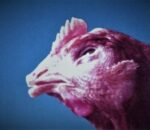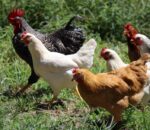Eggshell is an outer hard covering of egg amounting to about 11 percent of total egg weight. It is mainly made up of calcium carbonate. Eggshell provides a protective covering to liquid protein beside it helps in the gaseous exchange of developing embryos through 6000 to 8000 small pores present throughout the shell. Shell is also loosely covered with chalky powder known as cuticle which partially blocks the pores to prevent excessive evaporation of moisture from eggs and also physically blocks the entrance of micro-organisms in the egg. The cuticle is bacteriostatic in nature.
There are two layers that are present beneath the eggshell and known as inner and outer shell membranes. Both layers together are 0.01 to 0.02 mm thick. The outer membrane is slightly thicker than the inner membrane and remains attached to the shell throughout the egg except in the area where the air cell is formed. They are also major lines of defense against microbial invasion of eggs.
Few egg shell properties are listed below that determines the egg quality.
1. Shell Shape
The ideal egg has an oval shape with one end larger than the other, and it tapers towards the small end. The egg reader must have a mental picture of an ideal egg. The normal or usual egg is allotted an A grade and a slightly abnormal shape is given B grade.
2. Shell Soundness
Eggshell can be sound, cracked, leaked, or smashed. Only sound eggs are permitted for grading. Many times the cracks have blind checks where membranes are intact and cannot be observed by external observation and pass through grader unobserved. Such cracked eggs have weak shells and may break and spoil other eggs in transit.
3. Shell Cleanliness
A clean egg must be free from stain or external material adhering to it. Eggs having small specks or stains that do not distract the buyer’s attention are also classified as clean eggs and awarded an A grade. B grade includes all the eggs which do not qualify for an A grade.
4. Shell Colour
Shell colour is found in white, yellow or in different shades of brown. In general, the Mediterranean class of chickens (Leghorn, etc) lay white eggs and the chickens of the other three classes (Asiatic, American, and English) lay yellow to brown eggs. There are several methods of measuring shell colour like visual scoring, photo-electric determination of percentage reflectance, and automatic grading of shell colour. Shell colour gradually fades with the age of the bird and time of storage.
5. Shell Porosity
Shell pores permit the exchange of water vapours and gases between the contents of egg and outer atmosphere and hence plays a great role in maintaining internal quality. Low porosity of eggs is better for table eggs because less loss of moisture during storage. But low porosity might become problem in hatching eggs. There are several methods of measuring shell porosity which could be divided in three groups:
(a) Pores directly counted
(b) Loss in weight is measured under standard conditions of temperature and humidity
(c) Rate of flow of liquid or gas is measured under pressure.
Out of these, the best method is to measure rate of loss in egg weight under standard conditions.
6. Shell Strength/Density
Shell strength refers to the ability of the shell to remain sound during transit from hen to consumer. It is economically the most important egg characteristic. Methods of direct measurements of eggshell strength can be divided into two groups
1. Those measuring the egg’s resistance to a gradually increasing load (crushing and puncturing).
2. Those measuring its resistance to sudden jerks (impact).
Indirect methods of measuring shell strength are measuring shell thickness, shell weight per unit area of the shell, percentage shell of total eggs, the specific gravity of eggs, shell thickness measured by Beta-ray back-scatter. Out of these the best method to assess shell strength is the measurement of egg-specific gravity but the limitation is that specific gravity changes with the age of the egg.
If you want to know about the process of molting in chickens and its different phases then click here.


